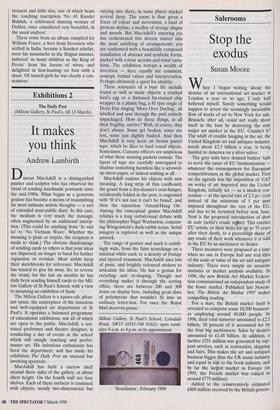Salerooms
Stop the exodus
Susan Moore When I began writing about the demise of an international art .market in London a year or so ago, I only half believed myself. Surely something would happen to arrest the seemingly inexorable flow of works of art to New York for sale. Brussels, after all, could not really shoot itself in the foot by destroying the only major art market in the EU. Couldn't it? The whiff of cordite hanging in the air, the United Kingdom art and antiques industry, worth about £2.5 billion a year, is being handed to America on a silver salver.
The grey suits have donned butlers' tails to serve the cause of EU harmonisation whatever the consequences for European competitiveness in the global market. First on the agenda was the imposition of VAT on works of art imported into the United Kingdom, initially set — as a modest con- cession — at the special rate of 2.5 per cent instead of the minimum of 5 per cent imposed throughout the rest of the EU, and due to be reviewed before next June. Next is the proposed introduction of droit de suite (artist's resale rights). This entitles EU artists, or their heirs for up to 70 years after their death, to a percentage share of any resale of their work whenever it is sold in the EU by an auctioneer or dealer.
These measures were proposed at a time when no one in Europe had any real idea of the scale or value of the art and antiques industry. There were simply no accurate statistics or market analysis available. In 1996, the new British Art Market Federa- tion commissioned an independent study of the home market. Published last Novem- ber, The British Art Market 1997 makes compelling reading.
For a start, the British market itself is revealed to comprise some 10,200 business- es employing around 40,000 people. In 1996, their total turnover amounted to £2.2 billion, 38 percent of it accounted for by the four big auctioneers. Sales by dealers amounted to £1.45 billion. In addition, a further £251 million was generated by sup- port services, such as restoration, shipping and fairs. This makes the art and antiques business bigger than the UK music industry and equal in site to the book industry, and by far the largest market in Europe (in 1995, the French market was- valued at around £775 million). Added to the conservatively estimated £469 million received by the British govern- ment from corporation tax, income tax and VAT on sales in the art trade, are the invis- ible earnings brought to London hotels, restaurants and the like by foreign collec- tors. In 1995, these visitors who regarded the art market as either a 'very important' or 'quite important' reason for their visit spent an estimated £2.8 billion in Britain.
Since the introduction of import VAT in 1994, art imports from non-EU countries to the United Kingdom have already fallen by a dramatic 40 per cent. Imports from America and Switzerland (the two other major art markets) declined by 17 per cent and 65 per cent respectively; imports from Hong Kong were down 82 per cent. If the import VAT rate increased to 5 per cent or theoretically more, even fewer works of art would make their way to Britain for sale.
Had droit de suite been enforced here in 1996, some £243 million of auction-house sales plus £130 million of dealers' sales would have been subject to the levy. Three- quarters of these droit de suite-eligible items were consigned by vendors outside the EU. If the United Kingdom lost this business to Geneva or New York where there is no droit de suite, the level of eligi- ble sales would be just £105 million, result- ing in only £2.5 million being raised about as much as the estimated administra- tion costs of the levy.
If this trade were lost, not only earnings of some £65 million would be at stake but some 5,000 jobs. The United Kingdom art market would almost certainly become entirely domestic, as is now the case in France. In Belgium, the introduction of droit de suite at 4 per cent and VAT at 20 per cent on the margin of profit (6 per cent on the total price before that) since 1996, has effectively destroyed a market which was ranked sixth in the world in 1970.
Has the report had any effect? Not a great deal, it seems. According to the inde- fatigable and ever-optimistic Anthony Browne, chairman of BAMF, 'the argu- ments against the imposition of droit de suite, and even of increased import VAT, are fairly unassailable on economic grounds. There is a growing realisation that no one in Europe will benefit if London loses its market position.' But not everyone seems to care, particularly those with the least to lose. The German art trade, for one, unlike the French, remains utterly opposed to the British retaining any mar- ket advantages. The fall-out contingency plans of the auction houses, meanwhile, are continuing apace. Potentially lucrative new markets are being sniffed out across the globe. New York itself goes from strength to strength, incredulous that Europe is giving it all up. Even the recent fanfare celebrating the unveiling of Sotheby's grand new Paris headquarters, prior to the opening up of the French market to foreign auctioneers, seems to herald a strangely unambitious operation. According to the Princesse Laure de Beauvau-Craon, managing direc- tor of Sotheby's France, Paris is a market for art works valued at £10,000 to £30,000.
Until someone else shoots the butler in the other foot, every great work of Euro- pean art, and everything else of note besides, will go to the market outside Europe, and the sales schedules of all the once great European markets will be about as exciting as the notices and announce- ments in the parish magazine.



























































 Previous page
Previous page